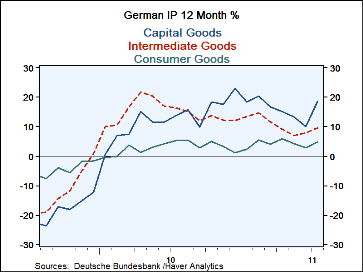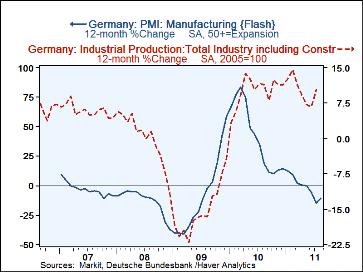 Global| Sep 07 2011
Global| Sep 07 2011German Capital Goods Are Sharply Higher
Summary
Industrial output in Germany rose by a sharp 4% in July after falling by 1% in June. With consumer goods slackening their pace over three-months capital goods output is ramping up over all horizons. Capital goods orders surged by 7.5% [...]
Industrial output in Germany rose by a sharp 4% in July after falling by 1% in June. With consumer goods slackening their pace over three-months capital goods output is ramping up over all horizons. Capital goods orders surged by 7.5% in July after dropping by 2.8% in June. Capital goods orders have been consistently strong. They are now on an accelerating profile up from 18% Yr/Yr, 22% over six months and 31% over three-months. Intermediate goods output is accelerating, too. Even consumer goods that slowed over three-months are doing well over six months and their three-month growth rate of consumer goods output is ahead of its 12-month rate of growth.
Despite a good deal of weakness in many economic indicators the current economic assessments continue to be stronger than the survey data. While we can speculate that survey data are more topical, potentially more flexible, and so on, the fact is that survey data have been on a declining path for some time (think of the ongoing weakness in the MFG and Services PMIs not just this month’s repots). It remains a bit of a mystery whether the ‘real time’ economic data are really going to continue to push ahead and if the survey data will snap out of it, having been the victims of events that put off consumers and factory managers but did not so much disrupt actual activity. While I remain skeptical of such an interpretation, the German ‘real time’ data are now quite a bit different from what survey data to date would have predicted. We are in a critical period in which either real tangible German factory data will become suddenly weak or we will begin to doubt the message in the weakening industrial surveys (see graph).
| Total German IP | |||||||
|---|---|---|---|---|---|---|---|
| SAAR Except M/M | Jul-11 | Jun-11 | May-11 | 3Mo | 6Mo | 12Mo | Q-2-D |
| IP total | 4.0% | -1.0% | 0.9% | 16.8% | 12.9% | 10.3% | 24.2% |
| Consumer | 2.5% | -1.1% | 0.0% | 5.4% | 7.9% | 4.8% | 10.7% |
| Capital | 7.5% | -2.8% | 2.6% | 31.9% | 22.2% | 18.5% | 44.6% |
| Intermed | 2.3% | 0.6% | 0.8% | 15.8% | 12.8% | 9.7% | 19.3% |
| Memo | |||||||
| Construction | 3.2% | -3.7% | -0.2% | -2.9% | 6.4% | 6.5% | 3.7% |
| MFG IP | 4.6% | -1.2% | 1.5% | 20.9% | 16.1% | 12.5% | 28.4% |
| Real MFG Orders | -2.8% | 1.8% | 0.0 | 1.7% | 4.8% | 8.7% | -6.6% |
Robert Brusca
AuthorMore in Author Profile »Robert A. Brusca is Chief Economist of Fact and Opinion Economics, a consulting firm he founded in Manhattan. He has been an economist on Wall Street for over 25 years. He has visited central banking and large institutional clients in over 30 countries in his career as an economist. Mr. Brusca was a Divisional Research Chief at the Federal Reserve Bank of NY (Chief of the International Financial markets Division), a Fed Watcher at Irving Trust and Chief Economist at Nikko Securities International. He is widely quoted and appears in various media. Mr. Brusca holds an MA and Ph.D. in economics from Michigan State University and a BA in Economics from the University of Michigan. His research pursues his strong interests in non aligned policy economics as well as international economics. FAO Economics’ research targets investors to assist them in making better investment decisions in stocks, bonds and in a variety of international assets. The company does not manage money and has no conflicts in giving economic advice.








